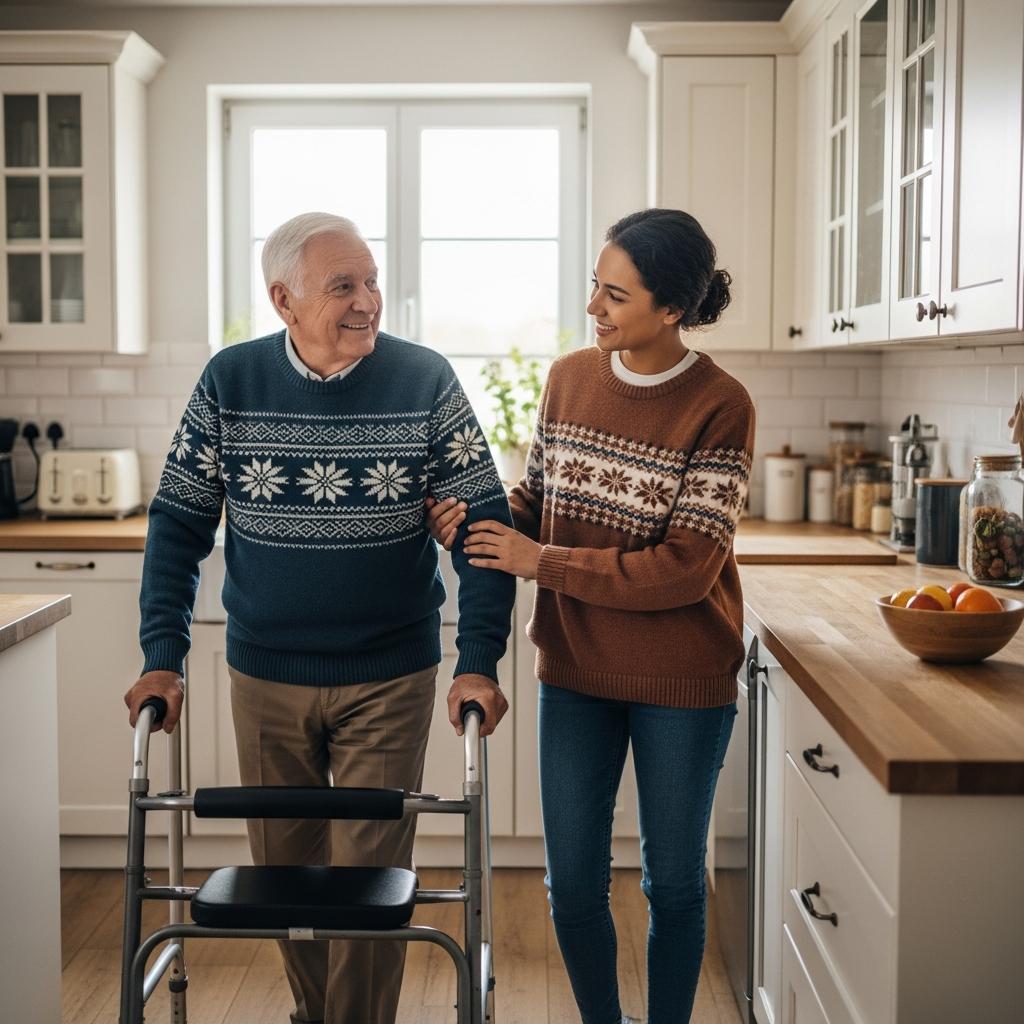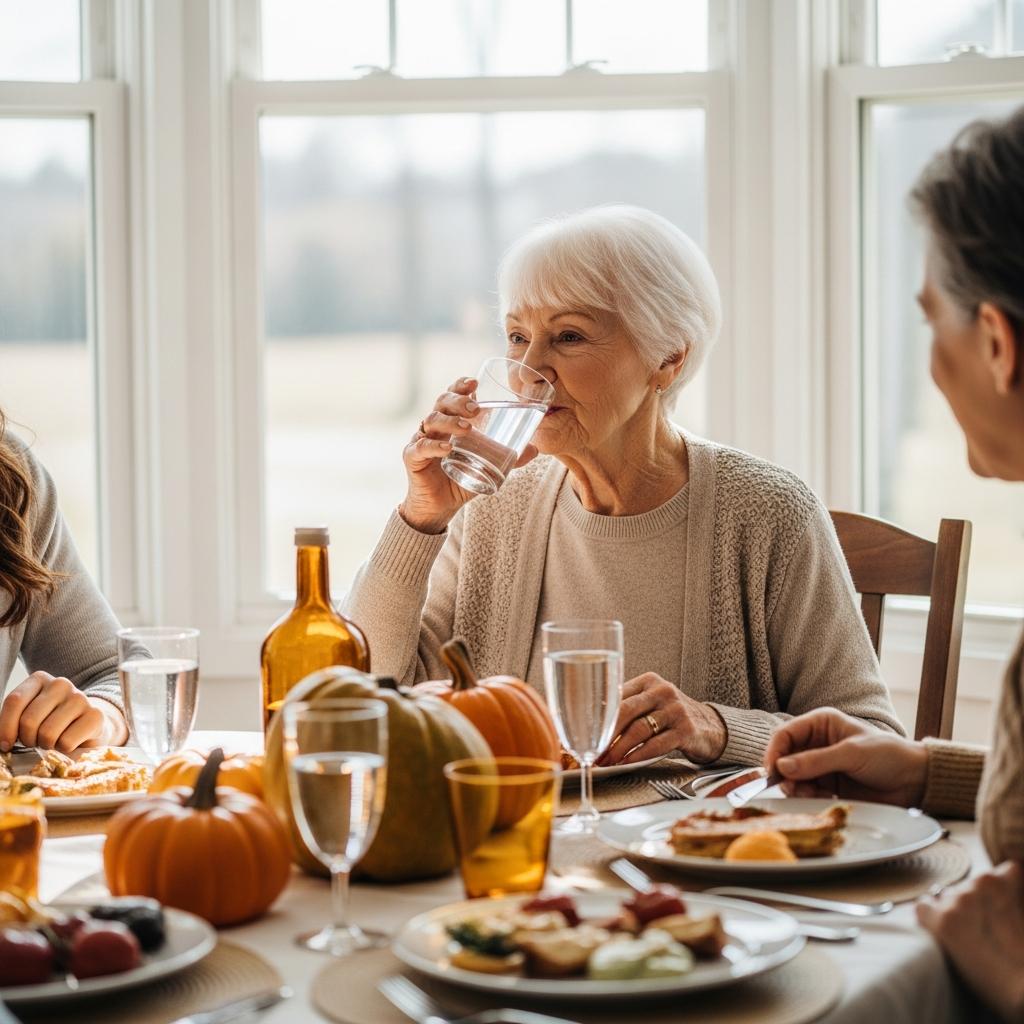You’ve probably already started mentally running through your Thanksgiving checklist—the menu, the seating arrangements, who’s bringing what dish. But here’s what most families don’t think about until it’s too late: Thanksgiving is one of the riskiest days of the year for older adults.
It’s not the turkey that’s dangerous. It’s everything else.
The familiar house that suddenly has twenty people moving through it. The routine that gets completely disrupted. The subtle signs of confusion or exhaustion that get mistaken for holiday excitement.
By the time most caregivers realize something’s wrong, they’re already dealing with a fall, a medication crisis, or a trip to the ER.
But here’s the good news:
you’re already ahead of the game just by thinking about this now. Most families don’t prepare, but you can. And with a few strategic steps this week, you can actually enjoy Thanksgiving while keeping your loved one safe.

The Traffic Pattern Problem: When Your Home Becomes a Hazard Zone
Here’s what happens at every Thanksgiving gathering: familiar, safe spaces transform into obstacle courses.
Your mom’s lived in that house for thirty years. She knows every floorboard, every light switch, every step. But today? There are coats piled on the chair she uses to steady herself.
Someone’s moved the ottoman she usually steps around. Kids are running through the hallway she walks down to get to the bathroom. And suddenly, the route she could navigate with her eyes closed becomes a minefield.
What Makes This Especially Dangerous
The problem isn’t just the obstacles—it’s that your loved one won’t adjust their expectations. Their muscle memory says “turn here, reach there,” but the environment has changed. They’re operating on autopilot in conditions that require full attention, and that’s when falls happen.
Falls during family gatherings are particularly dangerous because everyone’s distracted. By the time someone notices your loved one struggling to get up from a too-low chair or navigating around bags in the hallway, they might already be off-balance.
If you’re looking for comprehensive strategies to make your home safer year-round, check out our ultimate fall prevention checklist for room-by-room safety tips.
Your Action Plan Before Thursday
Walk through your home this week—not as someone who lives there, but as someone who’s 75, tired, and navigating with a cane. Where are the choke points? What gets in the way of clear paths?
Create a designated safe zone. This is one chair, one lamp, one clear path to the bathroom that stays obstacle-free all day. Let every guest know: this area is off-limits for coats, bags, and kids playing.
Mark it in your mind now. When you’re setting up on Thursday morning, protect this zone first before anything else.
Ready to discover more innovative strategies for healthy, comfortable aging? Subscribe to our newsletter for expert-tested tips and product recommendations designed specifically for older adults.

The Medical Management Crisis: What Happens When Routines Collapse
Let’s talk about something that sounds simple until it isn’t: medication schedules.
Your dad takes his blood pressure pill at 8 AM with breakfast. He takes his diabetes medication at noon with lunch. He takes his heart medication at 6 PM with dinner. On a normal day, this runs like clockwork. But on Thanksgiving?
Breakfast happens at 10 AM because people are sleeping in. Lunch disappears entirely because everyone’s grazing on appetizers. Dinner is at 2 PM because that’s when the turkey’s ready. And suddenly, a carefully calibrated medication routine is completely disrupted.
Why This Creates a Perfect Storm
Medications with tight timing requirements don’t care that it’s a holiday. Blood pressure medications need consistent levels. Diabetes medications need to match food intake. And when everything shifts by hours, the consequences can be serious—ranging from dangerous blood sugar crashes to blood pressure spikes.
But it’s not just the timing. In the chaos of hosting or visiting, caregivers forget. Or they remember but can’t find the pill organizer in the unfamiliar kitchen. Or the older adult says they already took it (did they?), and no one’s certain.
Your Prevention Strategy
This week, create what professional caregivers call a “holiday medication protocol.” It’s simpler than it sounds.
First, call your loved one’s doctor’s office. Ask specifically: “Which medications have strict timing requirements, and which have flexibility windows?” Many medications can be taken an hour or two off schedule without issue, but some can’t. Know which is which.
Second, set phone alarms for Thursday—not just one, but three. One alarm for you, one for your loved one, and one on a phone that stays in the kitchen where everyone can hear it. When that alarm goes off, medication time happens, regardless of whether the turkey’s ready.
Third, create a backup system. Take a photo of all medications and dosages on your phone right now. If you can’t find the pill organizer Thursday morning, you’ll know exactly what to give. For caregivers managing complex medication schedules year-round, automatic pill dispensers can provide consistent medication management and peace of mind.

The Dehydration and Nutrition Minefield
Here’s a scenario that plays out in thousands of homes every Thanksgiving: your elderly mother, who normally drinks water throughout the day and eats regular, balanced meals, ends up drinking maybe one glass of water between 9 AM and 4 PM. She nibbles on appetizers but doesn’t eat a real meal. By evening, she’s exhausted, confused, or worse.
Everyone assumes she’s just tired from the excitement. What they’re actually seeing is dehydration and blood sugar dysregulation.
Why Holiday Eating Patterns Are Dangerous for Seniors
Older adults have a diminished thirst response—they often don’t feel thirsty even when their body needs water. On a normal day, caregivers prompt hydration throughout the day. But on Thanksgiving, everyone’s focused on the feast. No one’s tracking whether your loved one has had anything to drink since breakfast.
The eating pattern makes it worse. Grazing on salty appetizers without adequate water increases dehydration. Missing regular meals throws off blood sugar, especially for diabetics. And by the time symptoms appear—confusion, dizziness, fatigue—you’re already in crisis mode. These same safety concerns apply to other holiday gatherings—learn more about protecting seniors at summer celebrations where heat and crowds create additional risks.
How to Prevent a Nutrition Emergency
Start the day right. Before any guests arrive, make sure your loved one has a full breakfast at their normal time, with their usual amount of water or juice. This baseline matters.
Create a hydration station. Fill a clear water bottle in the morning and keep it within arm’s reach of your loved one all day. The goal is visual tracking—you should be able to glance over and see how much they’ve consumed. Refill it visibly so they see fresh water arriving.
Protect lunchtime. Even if Thanksgiving dinner is at 2 PM, give your loved one a real lunch at noon—not appetizers, an actual meal. A sandwich, soup, something substantial. This prevents the dangerous blood sugar drop that happens when someone fasts for six or seven hours waiting for a big meal.

Recognizing Overwhelm: When to Pull Back Before Crisis Hits
Here’s what experienced caregivers know that most families learn too late: there’s a point in every Thanksgiving gathering when you can still prevent a crisis, but only if you recognize the signs.
Your loved one isn’t going to say “I’m overwhelmed.” They want to participate. They don’t want to miss out. They don’t want to seem fragile or ruin everyone’s fun. So they push through—until they can’t anymore.
The Warning Signs Most People Miss
Overwhelm in older adults doesn’t look like stress in younger people. You’re not looking for someone who says they need a break. You’re watching for subtle changes in behavior.
They become quieter in conversation, even though they’re still sitting at the table. They start saying “what?” more often—not because they can’t hear, but because they can’t process information as quickly in stimulating environments. They might become unusually agreeable, just nodding along rather than engaging.
Physical signs are even more telling. Watch their hands—are they gripping the armrests more tightly? Notice their posture—are they leaning heavily on furniture when they move? Check their face—do they look tense around the eyes, even if they’re smiling?
These are your red flags. This is your window to act. Being able to recognize these subtle warning signs is a crucial caregiver skill—if you want to improve your ability to check on your loved one’s wellbeing during regular conversations, try our 5-minute phone call script that helps you gather important health information without seeming intrusive.
The Strategic Retreat
When you see these signs, you have about thirty minutes before things deteriorate significantly. Maybe less.
Create an exit strategy before the day begins. Identify a quiet room—ideally with a door that closes, comfortable seating, dim lighting, and access to a bathroom. Stock it with water, a snack, and maybe a blanket.
When you spot the warning signs, don’t announce anything dramatic. Simply suggest, “Let’s take a quick break,” or “Want to help me with something in the other room?” Once you’re in that quiet space, your loved one will likely admit they needed this.
The rule of thumb: thirty minutes of quiet for every two hours of activity. This isn’t negotiable. It’s not optional “if they seem tired.” It’s a scheduled necessity that prevents crisis.
Want more expert strategies for navigating the holidays safely and joyfully with older adults? Join our newsletter for practical tips that make caregiving easier year-round.

Your Pre-Thanksgiving Action Checklist
You can’t control everything on Thanksgiving. But you can control the most dangerous variables.
This Week’s Essential Prep
Monday or Tuesday: Call the doctor’s office about medication timing flexibility. Get specific answers about which medications can shift and which cannot.
Wednesday: Do your safety walkthrough. Identify and mark your safe zone. Move trip hazards. Check lighting in pathways your loved one will use.
Wednesday evening: Fill that water bottle. Prep an easy breakfast and lunch for Thursday. Set your three medication alarms. Put your loved one’s medication photo on your phone’s home screen.
Thursday morning: Establish the quiet room before guests arrive. Review your game plan with one other responsible adult so you have backup. If you’re coordinating Thanksgiving care with siblings or other family members, our guide on family caregiver coordination can help everyone stay on the same page and avoid miscommunication.
The One Thing That Matters Most
Here’s what you need to hear: you cannot prevent every possible problem. Your loved one might still get tired. They might still feel overwhelmed. Something might still go wrong.
But by preparing for the big five dangers—traffic patterns, medication management, hydration, nutrition, and overwhelm—you’ve dramatically reduced the risk of serious harm. You’ve created backup systems. You’ve built in safety nets.
Most importantly, you’ve given yourself permission to prioritize safety over perfection. Thanksgiving dinner doesn’t have to be perfect. The house doesn’t have to look like a magazine. What matters is that everyone makes it through the day safely.
And now you have a plan to make that happen.
This Thanksgiving, you’re not just hosting or attending a gathering. You’re standing between your loved one and the most common holiday dangers. That’s not a burden—that’s the strength that makes you an exceptional caregiver.
Take One Action This Week
Don’t try to do everything at once. Start with the easiest win: make that phone call to the doctor’s office about medication timing. Just that one call can prevent the most common Thanksgiving crisis.
Everything else will follow. You’ve got this.

![Elderly woman drinking water thanksgiving table[1]](https://www.grayingwithgrace.com/wp-content/uploads/2025/11/elderly_woman_drinking_water_thanksgiving_table1-1-e1762886522997.jpg)
![Older woman walker daughter garden walk[1]](https://www.grayingwithgrace.com/wp-content/uploads/2025/11/older_woman_walker_daughter_garden_walk1-e1763402910723-450x300.jpg)
![Senior man curbside pickup holiday shopping[1]](https://www.grayingwithgrace.com/wp-content/uploads/2025/11/senior_man_curbside_pickup_holiday_shopping1-e1762887214923-450x300.jpg)
![Senior group autumn walk cane[1]](https://www.grayingwithgrace.com/wp-content/uploads/2025/11/senior_group_autumn_walk_cane1-e1762875262861-450x300.jpg)
![Asian grandfather granddaughter arranging potluck[1]](https://www.grayingwithgrace.com/wp-content/uploads/2025/11/asian_grandfather_granddaughter_arranging_potluck1-e1762874989504-450x300.jpg)
![Older woman with cane cooking with son[1]](https://www.grayingwithgrace.com/wp-content/uploads/2025/11/older_woman_with_cane_cooking_with_son1-e1762874788231-450x300.jpg)
![Elderly woman resting couch morning light[1]](https://www.grayingwithgrace.com/wp-content/uploads/2025/11/elderly_woman_resting_couch_morning_light1-e1762874558330-450x300.jpg)
![Elderly man with walker watching grandchild dessert[1]](https://www.grayingwithgrace.com/wp-content/uploads/2025/11/elderly_man_with_walker_watching_grandchild_dessert1-e1762874265659-450x300.jpg)
![Older couple setting up buffet kitchen counter[1]](https://www.grayingwithgrace.com/wp-content/uploads/2025/11/older_couple_setting_up_buffet_kitchen_counter1-e1762873850753-450x300.jpg)



